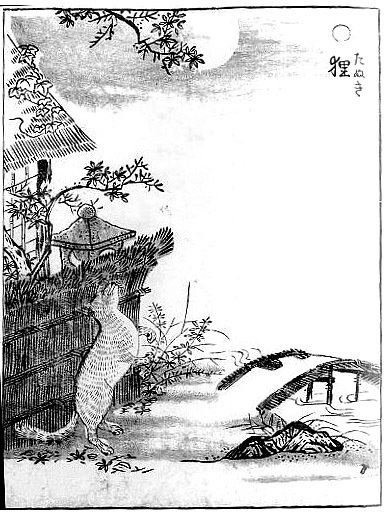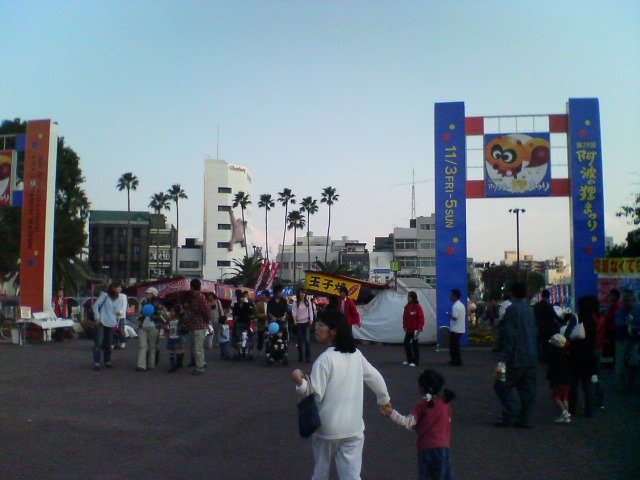|
Awa No Tanuki Festival
The Awa no Tanuki Festival (阿波の狸まつり) is a festival held each year in early November in Tokushima City, Tokushima Prefecture. Overview The Awa no Tanuki festival was first started in 1978 with the aims of promoting local culture, and has since grown into Tokushima's main Autumn festival. In 2006, the event saw good weather for all three days it was held, and the coincidence with a public holiday drew over 260,000 visitors. This is roughly the same size as the population of Tokushima City. While the festival is popularly known as the 'Tanuki Festival', Tokushima has been home to many tales of the ''tanuki'' since long past. Several of these tales talk of the interaction between tanuki and the local town residents, with the tanuki often acting as positive, changing forces. It should come as no surprise, then, that the tanuki was chosen as a symbol to energise local culture in this way. At current, the event's main grounds are the Aibahama Park grounds in Tokushima ... [...More Info...] [...Related Items...] OR: [Wikipedia] [Google] [Baidu] |
Tokushima City
is the capital city of Tokushima Prefecture on Shikoku island in Japan. , the city had an estimated population of 249,865 in 122085 households and a population density of 1305 persons per km².The total area of the city is . Geography The city is situated in the north-eastern part of Tokushima Prefecture at the mouth of the Yoshino River. In terms of layout and organization, Tokushima displays the typical characteristics of a Japanese castle town. Most of the city is located in the Tokushima plain and is flat, but the symbol of the city, Mt. Bizan, rises in the center, creating a scenic landscape. The southern part is a mountainous area with forests. Mountains Rivers * Akui River * Imagire River * Shinmachi River * Suketō River * Yoshino River Neighbouring municipalities Tokushima Prefecture * Komatsushima * Katsuura * Matsushige * Kitajima * Aizumi * Ishii * Kamiyama * Sanagōchi Demographics Per Japanese census data, the population of Tokushima has been grow ... [...More Info...] [...Related Items...] OR: [Wikipedia] [Google] [Baidu] |
Tokushima Prefecture
is a prefecture of Japan located on the island of Shikoku. Tokushima Prefecture has a population of 728,633 (1 October 2019) and has a geographic area of 4,146 km2 (1,601 sq mi). Tokushima Prefecture borders Kagawa Prefecture to the north, Ehime Prefecture to the west, and Kōchi Prefecture to the southwest. Tokushima is the capital and largest city of Tokushima Prefecture, with other major cities including Anan, Naruto, and Yoshinogawa. Tokushima Prefecture is located on the Kii Channel, connecting the Pacific Ocean and Seto Inland Sea, across from Wakayama Prefecture on the Kii Peninsula of the island of Honshu. Tokushima Prefecture is connected to Awaji Island across the Naruto Strait by the Ōnaruto Bridge as part of the Kobe-Awaji-Naruto Expressway, connecting the prefecture to the city of Kobe and the San'yō Expressway on Honshu. History Until the Meiji Restoration, Tokushima Prefecture was known as Awa Province. Tokushima Prefecture and Myodo Prefecture In ... [...More Info...] [...Related Items...] OR: [Wikipedia] [Google] [Baidu] |
Bake-danuki
''Bake-danuki'' () are a kind of ''yōkai'' (supernatural beings) found in the classics and in the folklore and legends of various places in Japan, commonly associated with the Japanese raccoon dog or ''tanuki''. Although the ''tanuki'' is a real, extant animal, the ''bake-danuki'' that appears in literature has always been depicted as a strange, even supernatural animal. The earliest appearance of the ''bake-danuki'' in literature, in the chapter about Empress Suiko in the '' Nihon Shoki'' written during the Nara period, there are such passages as "in two months of spring, there are tanuki in the country of Mutsu (), they turn into humans and sing songs ()." Bake-danuki subsequently appear in such classics as the Nihon Ryōiki and the Uji Shūi Monogatari. In some regions of Japan, ''bake-danuki'' are reputed to have abilities similar to those attributed to ''kitsune'' (foxes): they can shapeshift into other things or people, and can possess human beings. Many legends of ''tanuk ... [...More Info...] [...Related Items...] OR: [Wikipedia] [Google] [Baidu] |
Aibahama Park
Aibahama Park (藍場浜公園) is a park in Aiba-cho in Tokushima City in Tokushima Prefecture. Overview Found alongside the Shinmachi River that winds its way through the middle of Tokushima City, the Aibahama Park grounds are known as a popular place for events. In April there is the Hana Haru Festa, and the grounds are also used for one of the dancing stages in Awa Odori held during O-bon. Aibahama Park is also used during the local Awa no Tanuki Festival in November each year, and is the permanent home for the Tokushima Arts Foundation for Culture. * Local buildings / facilities - Tokushima Sogo、Tokushima CITY、Poppo-gai、Tokushima Press Facilities on the grounds * The Tokushima Arts Foundation for Culture * The Shinmachi River Access * Five minutes walk from the Japan Railways Group, JR Tokushima Station and bus terminal area. External links Tokushima City, Aibahama Park {{coord, 34.07424, 134.546889, format=dms, display=inline,title, type:landmark_regio ... [...More Info...] [...Related Items...] OR: [Wikipedia] [Google] [Baidu] |
Tokushima Arts Foundation For Culture
The Tokushima Arts Foundation for Culture (徳島県郷土文化会館) is a multi-purpose cultural facility found in the Aiba-cho district in Tokushima City, Tokushima Prefecture. It sits on the grounds of the Aibahama Park and runs alongside the Shinmachi River. Overview Location * 〒770-0835 Tokushima Prefecture, Tokushima City, Aiba-cho 2-14 (徳島県徳島市藍場町2丁目14番地) * TEL - 088-622-8121 * FAX - 088-622-8123 * Open Hours - 9:00~21:30 (Exhibitions until 17:00) * Open Period - January 4 to December 28 every year. Facilities * 1F - Multi-purpose hall (792 seats) * 2F - Special exhibition room * 3F - Exhibition room * 4F - Meeting rooms, etc. * 5F - Meeting rooms, etc. Access * Just eight minutes walk from the JR Tokushima Station is a junction passenger railway station located in the city of Tokushima in Tokushima Prefecture, Japan, operated by the Shikoku Railway Company (JR Shikoku). Lines Tokushima Station is the terminus of both the ... [...More Info...] [...Related Items...] OR: [Wikipedia] [Google] [Baidu] |
Awa Odori
The is held from 12 to 15 August as part of the Obon festival in Tokushima Prefecture on Shikoku in Japan. Awa Odori is the largest dance festival in Japan, attracting over 1.3 million tourists every year. Groups of choreographed dancers and musicians known as ''ren'' (連) dance through the streets, typically accompanied by the shamisen lute, taiko drums, shinobue flute and the kane bell. Performers wear traditional obon dance costumes, and chant and sing as they parade through the streets. ''Awa'' is the old feudal administration name for Tokushima Prefecture, and '' odori'' means "dance". History The earliest origins of the dance style are found in the Japanese Buddhist priestly dances of Nembutsu-odori and ''hiji-odori'' of the Kamakura period (1185–1333), and also in ''kumi-odori'', a lively harvest dance that was known to last for several days. The Awa Odori festival grew out of the tradition of the Bon Odori which is danced as part of the Bon "Festival of the Dead ... [...More Info...] [...Related Items...] OR: [Wikipedia] [Google] [Baidu] |
Awa Puppet Theatre
Awa (or variants) may refer to: People * Awa (given name), notable people named Awa or Hawa * Awá (Brazil), an indigenous people of Brazil * Awa-Kwaiker, an indigenous people of Colombia and Ecuador Languages * Awa language (China) or Wa (Va) language, language of the Wa people of Burma and China * Awa language (Papua New Guinea), a Kainantu language of Papua New Guinea * Awa Pit language, a Barbacoan language spoken by the Awa-Kwaiker people in Colombia and Ecuador * Awadhi language (ISO 639 code: awa), an Eastern Hindi language spoken in northern India * Guajá language or Awá, the language of the Awá people of Brazil * Khumi language or Awa, a Kukish language of Burma Music * Awa (musician) or Leena Peisa (born 1979), Finish musician * AWA (singer) or Awa Santesson-Sey (born 1997), Swedish singer * A-WA, Israeli hip-hop and world music band Places * Awa, Tokushima, Japan, a town * Awa District, Chiba, Japan, a modern geographical administrative division * Awa Dist ... [...More Info...] [...Related Items...] OR: [Wikipedia] [Google] [Baidu] |
Festivals In Japan
This is an incomplete list of festivals in Japan. Traditional festivals Film festivals Music festivals See also * Japanese festivals * Abare Festival Abare Festival is a Japanese festival commonly known as the ''Fire & Violence Festival''. It takes place in Ushitsu of Noto Peninsula and is dedicated to the Yasaka Shrine. The festival takes place every year in July on the first Friday and Satu ... * Matsuri float References {{DEFAULTSORT:Festivals in Japan Japan Japan ... [...More Info...] [...Related Items...] OR: [Wikipedia] [Google] [Baidu] |

